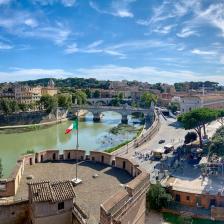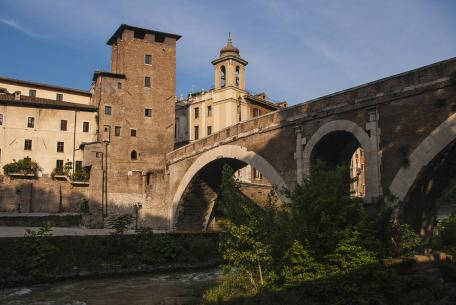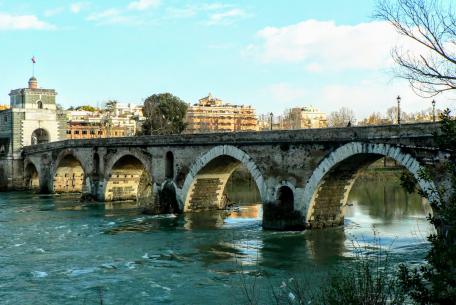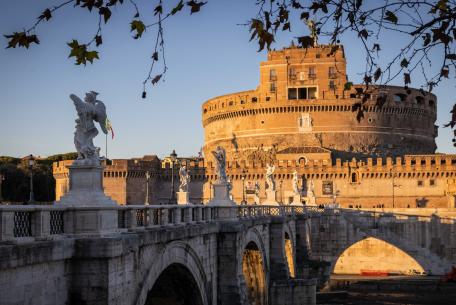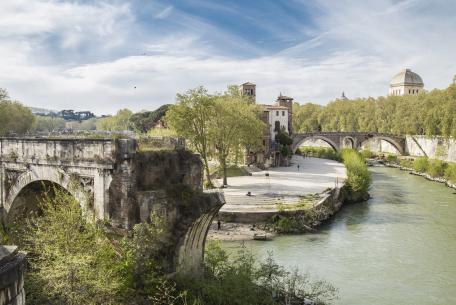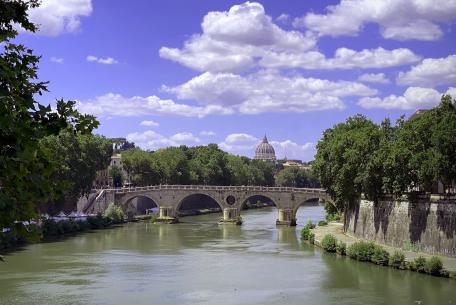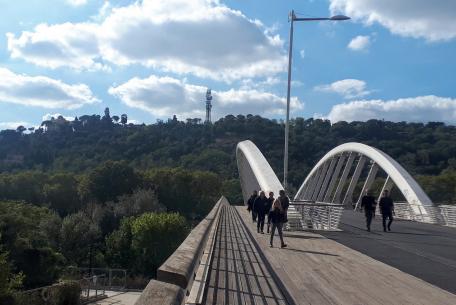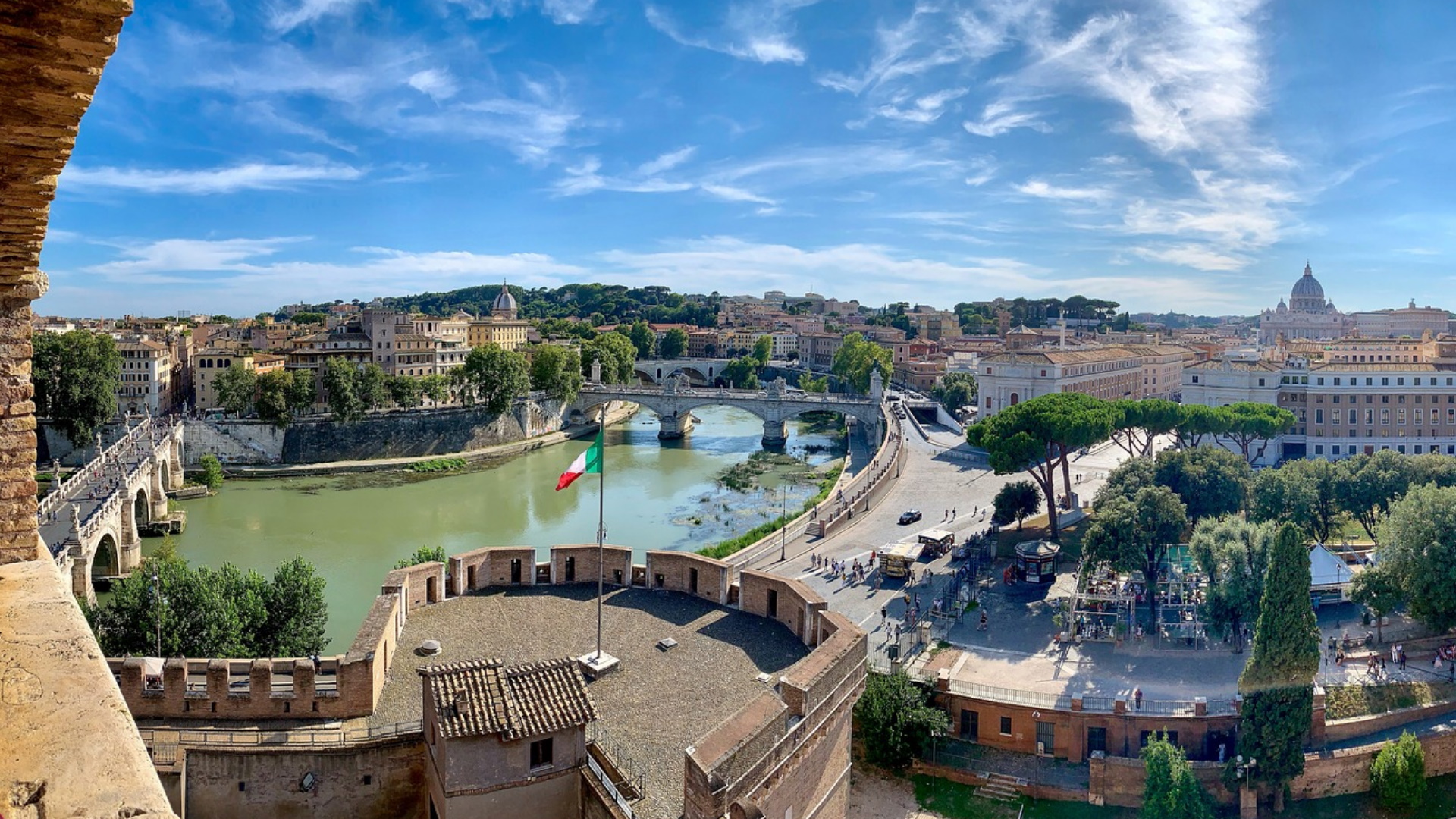
A universal symbol of union and connection between man and the city, bridges represented and still represent a fundamental and powerful strategic means for travel, relationships, and commerce in the history of Rome.
Along the Tiber, the river with which the Capital has always maintained a symbiotic relationship, there are dozens which, in addition to being the trait d'union between its banks, are splendid creations of human ingenuity and one of the major attractions of the Eternal City.
In a mix of ancient architectures, with structures still viable after millennia, and daring contemporary visions, the bridges of Rome offer us glimpses of unrepeatable beauty and unusual itineraries, where history, nature, and romance merge into unforgettable memories, all to tell.
Which of the bridges that cross the Tiber best express the identity of the most loved city in the world? Let's find out together.
#1 The oldest: Ponte Fabricio (Fabrician Bridge)
Together with Ponte Cestio (Bridge of Cestius), the ancient Ponte Fabricio connects the Tiberine Island to the left bank of the Tiber, more precisely, the old Jewish Ghetto with the characteristic Rione Trastevere.
Although it dates back to 62 BC, it is the best-preserved Roman bridge and the oldest still in use. According to the historian Livy, it replaced a wooden bridge, which already existed in 192 BC.
Four inscriptions in large letters engraved on its arches have also handed down the name of its builder: Lucius Fabricius, at the time curator viarum, that is, in charge of the care and administration of the roads.
Following two floods of the Tiber, it was restored by Marcus Lollius and Quintus Aemilius Lepidus in the 1st century BC, as a small inscription attests. Poet Horace said it was the bridge where people in despair often threw themselves into the river.
Ponte Fabricio is also known as Ponte dei Quattro Capi (four heads) due to the presence, on the parapet, of some four-faced herms that would be there in memory of the four architects commissioned by Pope Sixtus V to restore the bridge. According to a popular legend, the four technicians came into conflict with one another for trivial reasons. The bridge built, the pope had them beheaded on the spot. The four-headed monument, carved in a single block of marble, has obliged them, ever since then, to an eternal contact. You can admire one of the herms reproduced in the nearby fountain monument dedicated to Giuseppe Gioacchino Belli, which shows the poet leaning on the bridge parapet.
When, during the Middle Ages, the Jewish community occupied the area on the left of the Tiber, the bridge was Pons Judaeorum, that is, of the Jews.
Guarding the bridge stands a tower known as the "Pulzella" (Maid) for the small female head in marble, set in the masonry. Legend has it that the fascinating sculpted face portrayed a young noblewoman who lived in 1350, locked up in the tower for refusing to marry an aristocrat chosen by her family in the futile wait for her beloved to return from the war. The sculpture can be dated to Roman times, even if, with its "stone" gaze turned towards the bridge, it seems to challenge those passing by to discover the identity hidden behind the enigmatic face eroded by time.
#2 The "night owl": Ponte Milvio (Milvian Bridge)
Located in the Flaminio district, in the northern quadrant of the city, together with Ponte Fabricio, Ponte Milvio is among the oldest bridges in Rome, a meeting place for young Romans and tourists who love to meet in the trendiest clubs and restaurants of the area.
It was built in 109 BC and has always played a decisive role in its strategic position. Over the centuries, the bridge and the surrounding areas have been the scene of fierce battles, such as the decisive one in 312 AD between Constantine and Maxentius ended with Constantine being crowned sole ruler of the Western Empire and that of 1849, during which Garibaldi and his supporters blow up part of it to slow down the advance of the French toward Rome.
Originally called "Mulvius," in the Middle Ages, it was called "Mollo" (soft) perhaps because of the collapse of a central arch and the subsequent temporary placement of a wooden walkway that swayed as pedestrians passed.
In 1805, the great architect Giuseppe Valadier designed its rearrangement, replacing the drawbridges in the Piazzale di Ponte Milvio with a fortified gate in neoclassical style, now known as Torretta Valadier (Valadier Turret). The opposite side of the bridge is decorated with the marble statues of Saint Johann Nepomuk by Agostino Cornacchini from 1731 and the Immaculate Conception by Domenico Pigiani from 1840.
Since then, the bridge has undergone several alterations until it assumed its current function as a pedestrian passage. Towards evening, suggestive artistic lighting scenographically enhances the shapes and the splendid architecture of the bridge and turret.
#3 The most charming: Ponte Sant'Angelo (Saint-Angelo Bridge)
The history of this magnificent bridge, which connects Hadrian's Mausoleum with the Vatican, is linked to events, some curious, others sad, that have happened over the centuries.
An interesting one is told by Dante as a pilgrim and witness of the first Jubilee in history, in the XVIII canto of the Inferno of the Divine Comedy: “…come i Roman per l’essercito molto, / l’anno del giubileo, su per lo ponte / hanno a passar la gente modo colto, / che da l’un lato tutti hanno la fronte / verso ’l castello e vanno a Santo Pietro; / da l’altra vanno verso il monte…” (...even as the Romans, for the mighty host, The year of Jubilee, upon the bridge, Have chosen a mode to pass the people over; For all upon one side towards the Castle Their faces have, and go unto St. Peter’s; On the other side they go towards the Mountain...
In the Holy Year 1450, however, due to an accident caused by the white mule carrying Pope Nicholas V, the parapets collapsed, and hundreds of people died by drowning.
Between 1488 and 1534, the area around the bridge wanted by Hadrian displayied the corpses of the executed people. The event gave birth to the proverb: 'There are more severed heads on the bridge than melons in the market.'
The most striking features of Ponte Sant'Angelo are the statues of the beautiful angels that decorate its parapets. Two were sculpted by the the genius of Gian Lorenzo Bernini and are today kept in the Basilica of Sant'Andrea delle Fratte. The others by his pupils.
Just before sunrise, along the bridge, you may come across a disturbing character wrapped in a scarlet cloak. It is Giovanni Battista Bugatti, the legendary Mastro Titta, the most famous executioner in Rome.
It is said that his ghost loves to walk along Ponte Sant'Angelo, one of the places where he executed some of the more than 500 condemned to death in his long career, and to offer a pinch of chewing tobacco to anyone he meets during his walks.
#4 The most "unfortunate": Aemilius Bridge
Today it is known as the Broken Bridge. But the large ruin with a decadent and poetic appearance that emerges from the waters of the Tiber, a short distance from the Tiberine Island, is what remains of the ancient Pons Aemilius, the first masonry bridge of Rome and perhaps the longest in antiquity.
Over the centuries, its name changed several times: Maximus Bridge, when Augustus Pontifex Maximus ordered its reconstruction; Santa Maria Bridge, when the Temple of Portunus was transformed into the church of Santa Maria Egiziaca and Pons Senatorium, when in 1144, probably, the Senators, the highest administrative office in the city, ordered its restoration.
Of great strategic importance, it connects the banks of the Tiber and favors trade between the city and the merchants arriving in Rome to sell their goods. It also allows easy access to the three most important places in the city: Capitol Hill, the Forum, and the Circus Maximus.
Its story, however, is somewhat troubled.
Perhaps because it is at an unfortunate point of the river oblique to the current, where the waters are particularly violent and often damage or destroy it. It undergoes innumerable reconstructions, including that of 1552, based on a project by Michelangelo. After just five years, a flood sweeps it away. In 1573, it conveyed the waters of the new Acqua Felice Acqueduct to Trastevere on behalf of Pope Gregory XIII Boncompagni Yet, another extremely violent flood on Christmas night in 1598 destroyed it, together with three of its arches.
The part still standing, anchored to the right bank, was transformed into a hanging garden until the end of the 18th century, but the lack of stability made it completely unusable.
In 1853 Pius IX put it back into operation with suspended metal walkways. This solution lasted until 1887, when the walkways were removed for the construction of the walls of the Tiber and the more modern and functional Palatine Bridge. Then, the bridge loses the two outermost arches, and for the Romans it becomes definitively "broken."
Despite its current appearance, we must not forget that even today, it continues to narrate a fundamental part of the millenary history of Rome, of which it was one of the most illustrious protagonists.
#5 The most romantic: Ponte Sisto (Sixtus Bridge)
A postcard background, in which you can see the Dome of St. Peter very close, for one of the most evocative and romantic bridges in Rome. Especially in the evening, you can enjoy a breathtaking view, walking hand in hand on Ponte Sisto among the pink, purple, and orange shades of the enchanting sunsets only Rome can offer.
The bridge was built on the occasion of the Jubilee of 1475 to facilitate the flow of pilgrims and to allow direct communication between the Vatican and the rest of the city.
In its place was a Roman bridge probably built by Agrippa, son-in-law of Augustus and dating back to 12 BC restored in 147, but which, seriously compromised by the flood and the subsequent overflow of the Tiber in 792, was called "broken," but only until the complete reconstruction for the Great Jubilee.
Affixed to the ends of the bridge were two unusual plaques in memory of its construction, removed to be preserved from the ravages of time. The transcriptions are still visible on the new parapets before Via Giulia.
At the center of the four arches that make it up is a circular opening that the Romans have pleasantly nicknamed Occhialone (big eye). In reality, it is a hydrometer created to monitor the water level of the Tiber and which gave rise to the curious saying: "Si a Ponte Sisto all'Occhialone ce passa l'acqua, pòi sta' sicuro che mezza Roma starà sott'acqua,” ( "If, water passes through the "big eye," be sure that half of Rome will be underwater.”
In 1877, Italy united, the traffic increased, and so did the section of the bridge with two metal walkways suspended on corbels added along its sides. However, the low resistance of the materials - soft and cast iron -made them unstable and dangerous and later removed. If you look at the sides of the bridge, you can still see where they were.
One of the ends of Ponte Sisto overlooks Piazza Trilussa, today one of the favorite places of the Capitoline nightlife for many young Romans and tourists. Take the opportunity to enter its intricate alleyways and characteristic squares to discover the many typical trattorias, inns, and small craft shops where you can rediscover the spirit of the Rome of the past.
#6 The most scenic: Ponte Duca d'Aosta (Duke of Aosta Bridge)
Two hundred twenty-two meters of white travertine from Tivoli, and a central span that alone measures a hundred metres, grandiosely join the refined palaces, monumental villas, and prestigious rowing clubs of Lungotevere Flaminio with the Foro Italico, the famous multi-sports complex of international importance which also includes the Stadio Olimpico, the Stadio dei Marmi, and the Stadio del Tennis.
Among the buildings of the modern era, Ponte Duca d'Aosta, the work of the architect Enrico Del Debbio inaugurated on 26 March 1939, is undoubtedly among the most daring and elegant. Despite its monumental size, its essential and harmonious lines make it one of rationalist architecture's grandest and most functional creations.
Also called Ponte del Foro Italico, Ponte Duca d'Aosta is 30 meters wide. Its lateral arches rest on the banks of the Tiber and serve as blowholes in the event of floods. Wide lateral stairways gently slope down towards the river.
The high reliefs that decorate the marble pillars at the four corners of the bridge reproduce scenes of battles fought on the Sile, Piave, Tagliamento, and Isonzo rivers and narrate the legendary deeds of the 3rd Army commanded by Duke Emanuele Filiberto of Savoy-Aosta who led the bloody resistance of the Italian Army in Caporetto.
The area on which the bridge stands today was known for the presence of "fiumaroli", singular characters who put on a show with daring tests of courage in the water and who frequented the bathing houses in vogue in the 19th century. The most renowned and popular among sunbathers were Polverini and the Isola dei Zibibbo, a strip of sand that emerged when the waters of the Tiber were low.
#7 The "youngest": Ponte della Musica - Armando Trovajoli (Music Bridge)
Harmoniously suspended between Lungotevere Flaminio and Lungotevere Cadorna, the Ponte della Musica - Armando Trovajoli, dedicated to the famous Roman composer, connects Renzo Piano's Auditorium Parco della Musica Ennio Morricone and Zaha Hadid's MAXXI with the Foro Italico sports complex and other extraordinary realities linked to the world of Fine Arts, Sport, and Science which make up the so-called Miglio delle Arti (Cultural mile). Structured in an east-west direction on the Villa Glori – Monte Mario route along the axis of via GuidoThe suggestive straight road it is the ideal place for walking, cycling, or simply enjoying the greenery of the city in the shade of some of the most innovative works of human ingenuity.
Inaugurated on 31 May 2011, the bridge is the work of the Buro Happold Studio in London, winner of the International Competition organized by Rome's municipality.
The Music Bridge, designed for pedestrians, cycle traffic, and ecological public transport, has a total weight of over 2000 tons. Its essential lines, though, give it elegance and a characteristic sinuosity that perfectly blends with the refined architecture of the area.
Its minimalist and contemporary design is also obtained thanks to materials such as steel, concrete, reinforced concrete, and wood which give the structure refined airiness and lightness. Furthermore, the two arches, inclined to the vertical plane, have no horizontal connection with the area above the 190-meter-long and 22-meter-wide deck, with the pedestrian paths facing the river without obstacles.
After sunset, lighting, skilfully designed to maximize the soft and supple shapes of the structure, dresses the bridge in a suggestive and moving atmosphere.
 Condividi
Condividi












































